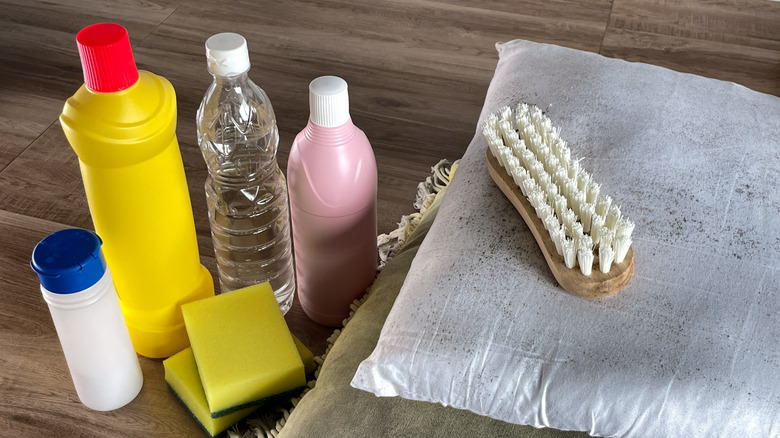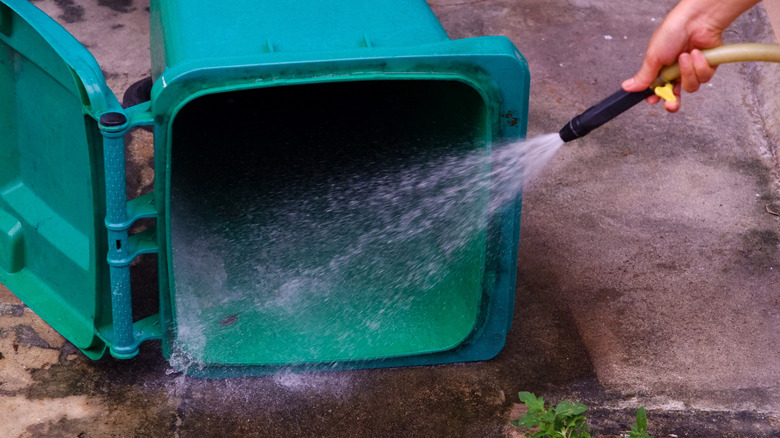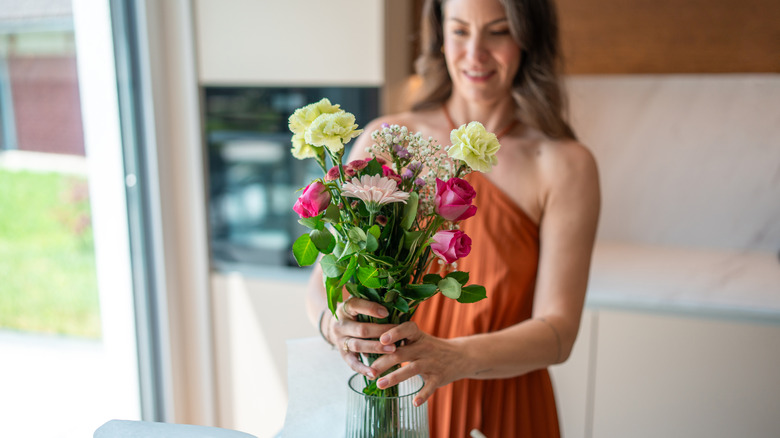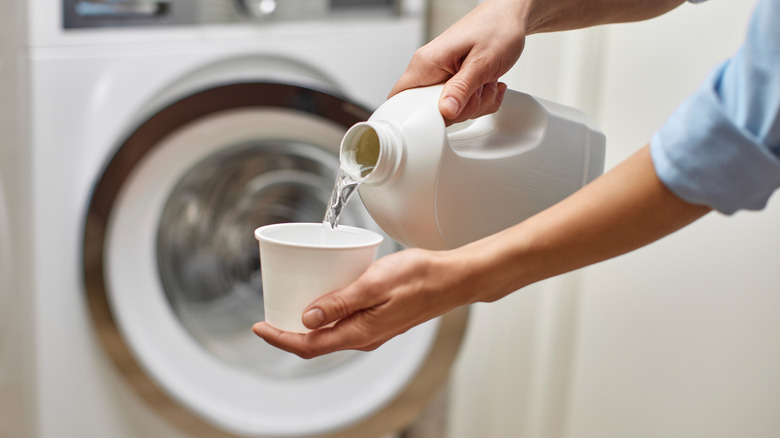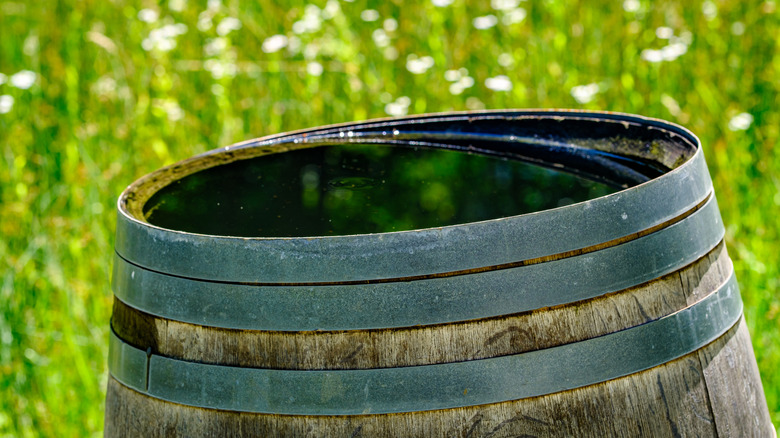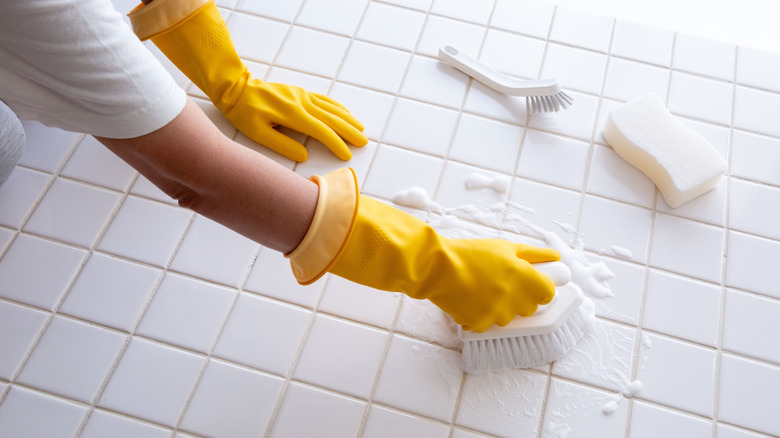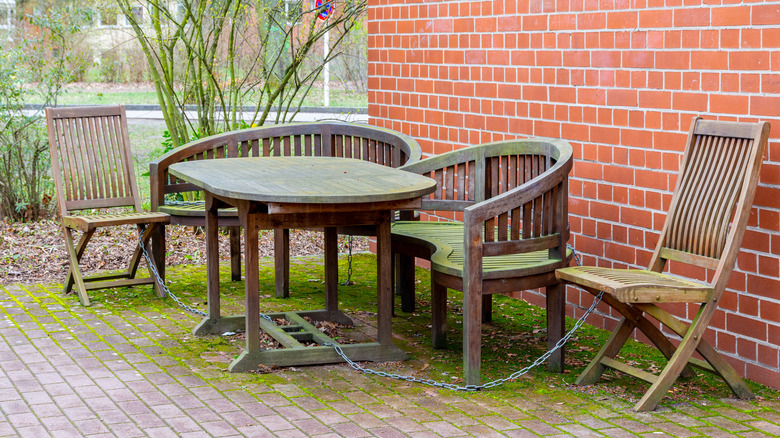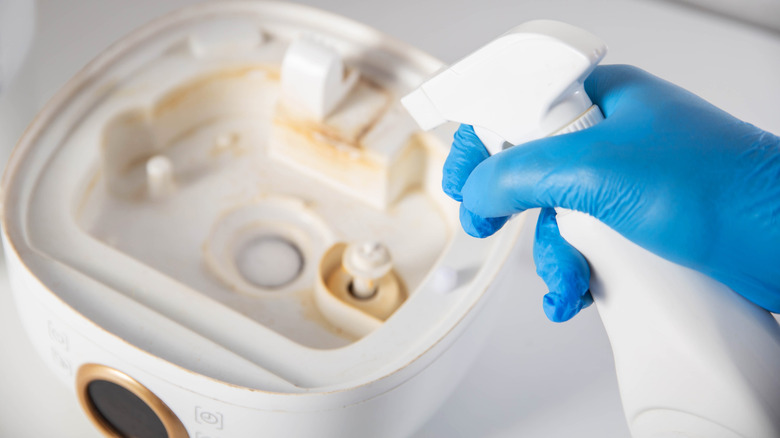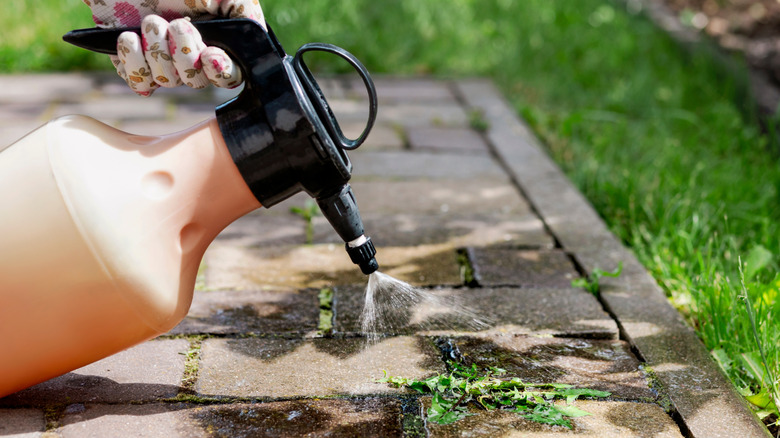11 Uses For Bleach Around Your Home Beyond Everyday Cleaning (& 4 To Skip)
We may receive a commission on purchases made from links.
It's fair to say that there are few households around the country that don't have a bottle of bleach stashed away somewhere. It's invaluable when it comes to keeping your bathroom clean and odor-free, and is a boon to those who need to keep surfaces disinfected to prevent the spread of harmful bacteria. But its uses go far beyond everyday cleaning.
In fact, a bottle of good old-fashioned chlorine bleach has the potential to solve a number of housekeeping conundrums, and not just indoors. Yes, as far as your interior goes, its robust cleaning and disinfectant properties can help you to remove mold, de-stain your favorite tea and coffee mugs, and even disinfect your humidifier. But it's also a reliable ally for avid gardeners. While its outdoor use should be as controlled as possible to prevent the leaching of harmful chemicals into the soil, when used carefully, it can help to mitigate against mosquitoes, decontaminate plant pots, and even remove moss and algae from your furniture.
In other words, bleach is a veritable wonder product. However, it's important not to get carried away. While chlorine bleach has plenty of uses outside of the bathroom, there are several hacks that should be avoided, despite being frequently touted as time and money-savers for thrifty homemakers. Some, like using it to clean cat litter trays, risk initiating a harmful, gaseous chemical reaction. Others, like cleaning your fridge, can cause untold damage to your appliance while potentially contaminating your food. Covering 11 recommended uses, plus four that you'd be better off skipping, this guide has everything you need to get more out of your go-to bottle of bleach.
Remove mold from your home
Unfortunately, if mold has made a home for itself inside porous materials like wood, then it may be difficult to eradicate altogether, as mold tends to root deeply in such materials. However, in non-porous surfaces, like tiles and walls, bleach can be a fantastic means of removing such unsightly and dangerous growth. Just try not to rely solely on bleach to solve your mold problem. Instead, use it in conjunction with measures that will help to prevent its reappearance in the future, like increasing air flow and reducing humidity.
It's important to take precautions before cleaning your room with bleach, like wearing a mask to avoid breathing in mold spores. Gloves are also advisable — remember that the active chemical in bleach, sodium hypochlorite, is caustic and can therefore cause serious irritation to your skin. Aim to use regular unscented household bleach (with a concentration between 4% and 9%), diluting just one cupful with a gallon of water. Scrub rougher surfaces with a stiff brush, and when you're done, rinse them with clean water and allow them to dry. Finally, if you have several days' worth of cleaning planned, then bear in mind that you may need to mix up separate batches for each task. Once diluted, bleach can quickly lose its efficacy, often in less than 24 hours.
Sanitize plastic toys
Using a half-cup of chlorine bleach with a gallon of warm water, you can easily create a solution that can rid your children's plastic toys of nasty pathogens. A good ten minutes of soaking should do the trick, after which you should rinse them as thoroughly as possible with clean water before allowing them to dry.
This method can also be used to disinfect their favorite bathtime toys. As for how often you should clean your kids' bath toys, it's recommended that you do it once a week. And if some of them are squirty toys that suck up water, then try to ensure they suck up enough of the bleach solution to effectively clean them inside. Equally, aim to be as fastidious as possible when cleaning them out, ensuring that they're suitably flushed with clean water once they've had enough time to soak.
Clean and disinfect your garbage cans
It's amazing how smelly garbage cans can become after even just a few weeks. Fortunately, all it takes is a good, timely cleaning and disinfecting to prevent your trash from smelling too bad, and bleach is the perfect partner for the job. Firstly, you'll need to give the can a thorough clean, using simple dish soap and warm water. Use a brush to clean the inner surfaces (plus a putty knife for more stubborn residues) before pouring the dirty water down the drain.
Next, it's time to rid your can of any lingering smells. Using bleach is one of the best ways to deodorize your trash can, and all you need is a gallon of warm water plus a third of a cup of bleach. Add it to your trusty spray bottle, then douse the surfaces of your can, allowing the mixture a few minutes to work its magic. If the weather allows, try to do this outside to avoid a build-up of bleach fumes in your house. Once it's had time to soak, douse your trash can with a hose to remove all of the bleach, then carefully pour the water down the drain, before upending the can (leaving it outside) and allowing it to dry.
Keep your flowers fresh for longer
There are many reasons to adorn your home with fresh flowers, but it can be tricky to keep them looking their best. Fortunately, and perhaps surprisingly, one of the best ways to keep your cuttings happy is with a drop of bleach. You only need a quarter of a teaspoon per liter of vase water, and while this might not seem like much, all you need is an additional teaspoon each of sugar and lemon juice to make your own homemade flower food.
The mixture provides your cut flowers with both food and nutrients, thanks to the sugar and citrus. The bleach, meanwhile, serves to keep bacteria at bay that might otherwise infiltrate the water and cause your cuttings to wilt too quickly. Aim to change the solution at least every two to three days, and if you can, keep your flowers away from direct sunlight, as this will cause the solution to lose its potency more quickly.
Remove stains and brightening your whites
Now, it is possible to brighten your whites without using bleach, and there are plenty of products on the market that are designed for precisely this purpose. But if you're trying to dazzle on a budget, and you already have a bottle of bleach to hand, then it could well be the best solution. At least, it could, provided that you're not trying to whiten silk or wool, as these are likely to become damaged and break down if exposed to chlorine bleach.
Less-hardy fabrics can be brightened using oxygen bleach, which is much gentler than its chlorinated cousin. Chlorine bleach, however, packs more of a punch on fabrics that can withstand it, especially when used in a hot wash. Of course, it's important to use bleach safely when whitening your clothes, and as for the amount, go easy. Appliance brand Whirlpool suggests using just a quarter-cup of bleach, depending on how badly soiled your fabrics are. Finally, if you have a bleach drawer in your machine, then the bleach can be added pre-wash. If you don't, you'll need to wait for the machine to start filling with water before you add it, since pouring it straight onto your clothes without water could easily damage your garments.
Deter mosquitoes in controlled spaces
Mosquitoes, for many, represent the exact opposite of a relaxing time in the garden. And while there are several mistakes that could be attracting mosquitoes to your yard, standing water is perhaps the most common, as it represents an alluring spot for them to lay their eggs. It's worth saying at this stage that, depending on where the standing water is, using bleach to treat it might not be the best idea.
If used in the wrong spot, bleach could potentially contaminate your soil, harming local wildlife and damaging your plants. In other words, you mustn't use bleach in your birdbath or pond! An occasional clean with a mild bleach solution could help to keep the water in your rain barrel clean and less attractive to mosquitoes; however, you'll need to be as careful as you can in ensuring that none of those bleachy chemicals leach out into your wider garden.
There are, however, other places in which bleach could provide a salve to your scratchy problem, and that's your gutters. Neglecting to clean your gutters can lead to all kinds of problems, and if it's been a minute since you last cleared yours out of detritus, then standing water could have started to build up. And if it has, then bleach might be the best solution to your mosquito problem. To get started, mix two tablespoons into a gallon of water. Next, place an empty bucket (large enough to catch all of the mixture) underneath your gutter's downpipe to prevent spillage into your yard. With that in place, pour the solution into your gutter, and allow it to run off. Once it has, try to mitigate against future build-ups of water by clearing your gutters of any blockages.
Restore dingy tile grout
If other DIY grout cleaning methods like water and baking soda have failed to restore your beautiful bathroom, then a sparing solution of bleach can be used to remove more stubborn stains. Rinsing thoroughly is key to preventing long-lasting damage and corrosion to the tiles, and ideally, you should only use bleach on sealed grout. If it's not sealed, then bleach's caustic nature can end up doing more harm than good.
Even with sealed grout, it's important to use the correct concentration of bleach. Shoot for approximately a third of a cup of bleach, mixing it with a gallon of water. And before you begin scrubbing away at your tiles, make sure that any fabrics, like bath mats, towels, and washcloths, have been moved away from the area, as any accidental spills or sprays are likely to stain them. When you're finished, give the entire area a thorough rinse with either a bucket of clean water or your showerhead, and give it plenty of time to fully dry before restocking your bath with your toiletries.
Kill moss and algae
There are certain situations in which you should not use bleach to kill moss and algae — principally those in which you can't control or contain the run-off. For example, while bleach can certainly be effective at killing moss and algae on driveways, containing the run-off of chemicals is difficult, and any that you don't catch will seep into the ground and contaminate the nearby area.
For more contained and manageable jobs, however, like cleaning outdoor seating sets, bleach can help lift a winter's worth of green from your favorite furniture. Mix a solution of one part bleach to nine parts water, and use a soft brush to scrub the affected area. It's always advisable to consult your furniture manufacturer's cleaning recommendations before you use strong chemicals, and even then, it's worth testing it first on a small, inconspicuous spot to ensure that it doesn't damage the material.
Disinfect your humidifier
If you don't clean your humidifier frequently enough, you risk you and your family breathing dank, stale air. And since the Environmental Protection Agency recommends disinfecting these appliances every three days, it's easy to fall behind on this crucial cleaning task. Don't worry, though — you needn't go out and buy a special cleaning solution to keep up with such a demanding schedule.
Just mix up a gallon of water with a teaspoon of liquid chlorine bleach, pouring as much as necessary into the tank to give it a thorough clean. Swish the solution around, then place the tank into the unit and allow it to drain into the reservoir. Allow the system to soak for around 20 minutes before flushing both the tank and reservoir with clean water. It's important to repeat this final stage until the smell has disappeared — the last thing you want to do is start humidifying your house with bleach.
Sterilize your garden pots before planting
After a long growing season, pathogens like fungi, bacteria, and viruses can begin to cling to your pots. If left uncleaned, these can cause untold harm to your future plants. What's more, these pathogens are often microscopic. In other words, even if your planters look clean, they could easily not be, which means that when your growing season comes to a close, it's important that you thoroughly clean your pots.
Given its disinfectant properties, bleach is a fantastic product for this job. However, like your trash can, it's important to clean your pots with soap and water first, using a soft brush to work away visible grease and grime. When that's done, mix up a solution of one part bleach to nine parts water, and use it to spray all the surfaces of your pots. You can also use it to clean larger metal tools, like shovels and rakes. Just avoid using it on tools that require a sharp edge, as the corrosive nature of bleach can cause them to dull. Finally, be careful using bleach in pots with drainage holes. Do it over a tarp or a drain, so that any escaping bleach doesn't accidentally contaminate your garden.
Remove tea stains from your mugs
Referred to as the "big guns" approach by Popular Science, bleach is a powerful agent when it comes to removing tough stains from your tea cups. It can also be used to remove those same stains from clothes and other surfaces. The best part? All you need is half a tablespoon's worth, plus some hot water with which to top it up.
Swirl the bleach gently before filling each cup with hot water, ensuring that its insides are evenly coated. Once you've topped them up, let them rest for around 15 minutes. Try to place them somewhere near a window so that the fumes can ventilate away from your interior, and when they've finished soaking, empty them into the sink. Wearing dish gloves, wipe around the inside of the cups with a soft sponge to lift any remaining grime before giving them a thorough rinse.
Never deodorize your cat's litter box with bleach
It doesn't matter how much you love your four-pawed friend; there's no denying that their litter trays can get smelly, fast. Knowing how often to clean cat litter trays is key to keeping odor to a minimum, but it's also important to know which chemicals you should, and more importantly, shouldn't use to do it.
Generally speaking, hot water and dish soap are all you should use to clean it. Bleach, however, should be avoided. Cat urine is rich in ammonia, while the bottle of bleach in your cleaning cupboard is chock-full of chlorine. Put the two together, and the resulting chemical reaction can produce toxic gases which, if inhaled, can cause serious respiratory problems. Human harm aside, cats are also highly sensitive to smell. In fact, felines have around 200 million scent receptors in their nose, compared to the mere five million that we humans have to work with.
Avoid using bleach to kill weeds
There are some household products that are best avoided when it comes to killing weeds, and they include bleach. It's not that bleach is unlikely to kill weeds. It's just that by using bleach, you risk causing untold damage to your wider garden, including your grass, plants, and soil.
As Master Horticulturist, Dan Ori, tells Horticulture Magazine, "You should not use bleach in the garden!" He explains that the environmental impact and negative side effects of using bleach can last for a painfully long time. Pair his advice with findings from studies that show how chlorine levels in soil can be fatal to various plants, and honestly, you're better off using a safe, store-bought weed killer instead.
Don't use bleach to clean garden tools
If you've read elsewhere that one of the best ways to clean your garden tools is with bleach, then this one might come as a surprise. Unfortunately, because bleach is corrosive to metal, it's perhaps the worst cleaning product to use on tools like pruning snips and shears. It's also not as effective as other products against plant-borne viruses.
Instead, consider using isopropyl alcohol. Sure, you might not have a bottle stashed as readily in your cupboard as bleach. But it's widely available. What's more, it's superb when it comes to killing viruses, fungi, and bacteria — precisely the things you need to avoid spreading during your next growing season.
Never clean your fridge with bleach
If there's one thing that you should avoid using to clean your refrigerator, it's bleach. While it's fantastic for disinfecting and deodorizing things like your trash can and plant pots, it risks doing far more harm than good if allowed anywhere near your fridge. Firstly, bleach solutions can degrade rubber seals, causing them to weaken and crack. Any metal parts are likely to suffer if bleach is applied to them, too, since the active chemical in bleach is corrosive.
Additionally, harsh and corrosive chemicals are perhaps the last thing you want contaminating your food. Even if you're meticulous about rinsing it away, there's always a chance that you could leave some residue behind. While you can soak things like cups and toys in clean water to ensure that bleach is flushed away, this isn't possible with a large appliance. For this reason, manufacturers typically recommend that you avoid using bleach to clean your fridge, and instead opt for washing up liquid and a soft sponge or cloth.
